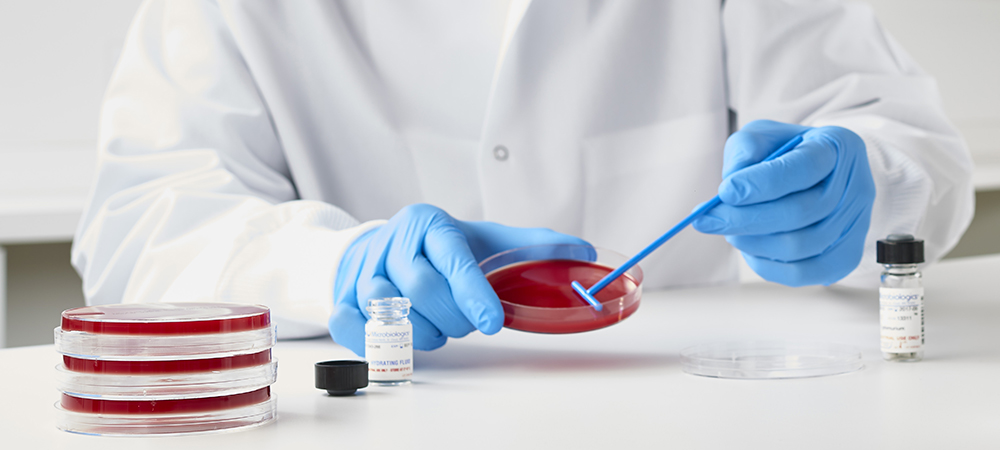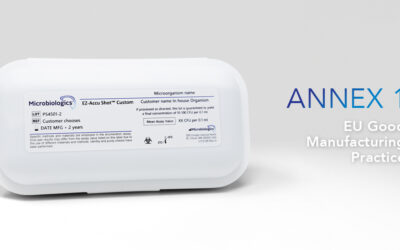Growth Promotion Test (GPT) – this combination of words might make you wince, but the test is essential for labs following pharmacopeia guidelines.
GPT is more challenging than a qualitative or ecometric test. It is deemed successful if a small number of cells (100 CFU or less) can grow in or on the media being tested. So, why perform such a demanding test? Here are seven reasons why GPT is important:
1. Qualify new batches of media prepared in-house
Murphy’s Law says if something can go wrong it will go wrong. Things that can go wrong during media production include:
- Improper mixing
- Forgetting an ingredient
- Prolonged heating
- Over-sterilizing media
USP <61>, Microbiological Examination of Nonsterile Products: Microbial Enumeration Tests, states, “Test each batch of ready-prepared medium and each batch of medium prepared either from dehydrated medium or from the ingredients described.”
2. Qualify purchased media
Problems can occur during shipping. The media may be exposed to extreme heat or cold when it is left on a truck without temperature control, a shipping dock or in customs.
3. Ensure a strain is grown at the correct temperature and under the correct atmospheric conditions
A failed growth promotion test can be caused by reasons other than poor media. Other causes are:
- Incorrect incubation temperature
- Wrong atmospheric conditions
Examples of problems caused by using less than optimal growth conditions include:
- No growth of Bacillus subtilis when it was grown in broth with no airspace in the tube
- Aspergilllus brasiliensis that did not turn black when the petri dish was sealed with tape
- Staphylococcus aureus that recovered more slowly on Mannitol Salt Agar when the plates were stacked 20 high instead of 4 high
- Saccharomyces cerevisiae that will not grow at 35°C
4. Test the proficiency of laboratory technicians
Periodic internal proficiency testing ensures technicians can successfully perform the GPT. Get your lab up to speed with these 10 Best Practices for Proficiency Testing.
5. Determine the best media, incubation temperature and atmospheric conditions for an environmental isolate
A little experimentation may be needed to choose the best media and growth conditions for difficult-to-grow environmental isolates such as Burkholderia cepacia and molds.
6. Choose the best brand of media for your laboratory
Although the formulation may be the same from brand to brand, they may not be created equal. Adjustments may need to be made in the formulation to meet the manufacturer’s specification or components may come from different sources. Take time to test media from more than one manufacturer to find which will produce the desired results for your lab. Pick a primary and secondary supplier for media to ensure consistency and stock of the culture media.
7. Determine shelf-life of media prepared in-house
Shelf-life varies widely with the type of medium. Factors that influence shelf-life are sterilization method, preservation and packaging procedures, storage temperature and exposure to light. Each laboratory needs to determine the shelf-life of the media under their storage conditions.
Now that you know why the test is important, become a GPT expert by reading our 10 Tips for Growth Promotion Testing. Then check out our GPT products that can simplify testing in your lab.






Esta interesante para ayudar a mis clientes en el desarrollo de investigaciones.
Less than 1{21568500cbbe79274f48cf710db15c141839bb6fa05d0e4f823963bc4a710758} of bacteria will grow on known growth media. There will always be unexplainable results; that’s what makes microbiology interesting. Much of Regulatory bacteriology pays scant regard to general bacteriology, and I suspect very few companies have media kitchens any more. Why is B. cepacia difficult to culture? Has anybody asked a general microbiologist or performed a literature review? In any QA supply chain we have to decide whether the media supplier provides goods of cGMP standard. Staff training is an internal issue. That’s what cGMP is all about.
concerning the GPT test for media prepared in lab should be compared the results by a media previously approved. if i prepared a media for the first time with ehich media i want to compare? thank you
Hello – if you have never performed the growth promotion test before on the type of medium you purchased or made in-house, you have no historical data with which to make a comparison. Microbiologics has two possible solutions to this dilemma:
• One, test three lots of the medium and compare results. Testing should be done at least in duplicate. All results should meet specifications for recovery and macroscopic characteristics. The results for all three lots should be within a factor of two of each other.
• Two, test the medium against another brand of ready-made medium from a reputable manufacturer. The media should be tested in parallel and should have the same formulation.
Please note that the methods listed above are possible solutions. You may want to check with your auditor to see if they have other suggestions.
What is the reasons of failure GPT in Mannital salt agar?
If you have experience failure on GPT on Mannitol Salt agar using a Microbiologics please contact our Technical Support team at techsupport@microbiolgoics.com or 320.229.7045
In this blog post, the example failure on Mannitol Salt was caused by the plates being stacked too high. When plates are stacked over 5 high, the plates in the middle take longer to equilibrate to the temperature of the incubator than the plates on the top and bottom of the stack. This delay decreases the growth time of the cells on the plates in the middle of the stack. When the plates are all checked for growth at the same time, the plate on the top and bottom of the stack will have grown more than those in the middle of the stack. Colonies will appear larger and the differential macroscopic characteristics observed more clearly.